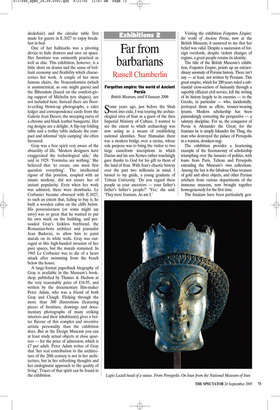Far from barbarians
Russell Chamberlin
Forgotten empire: the world of Ancient Persia
British Museum, until 8 January 2006
Some years ago, just before the Shah went into exile, I was touring the archaeological sites of Iran as a guest of the then Imperial Ministry of Culture. I wanted to see the extent to which archaeology was now acting as a means of establishing national identities. Near Hamadan there was a modern bridge over a ravine, whose sole purpose was to bring the visitor to two large cuneiform inscriptions in which Darius and his son Xerxes rather touchingly gave thanks to God for his gift to them of the land of Iran. With Iran’s chaotic history over the past two millennia in mind, I turned to my guide, a young graduate of Tehran University. ‘Do you regard these people as your ancestors — your father’s father’s father’s people?’ ‘Yes,’ she said. ‘They were Iranians. As am I.’ Visiting the exhibition Forgotten Empire: the world of Ancient Persia, now at the British Museum, it occurred to me that her belief was valid. Despite a succession of foreign overlords, despite violent changes of regime, a great people retains its identity.
The title of the British Museum’s exhibition, Forgotten Empire, points up an extraordinary anomaly of Persian history. There isn’t any — at least, not written by Persians. This great empire, which for 200 years ruled a substantial cross-section of humanity through a superbly efficient civil service, left the writing of its history largely to its enemies — to the Greeks, in particular — who, incidentally, portrayed them as effete, trouser-wearing tyrants. Modern scholarship has been painstakingly correcting the perspective — a salutary discipline. For us, the conqueror of Persia is Alexander the Great; for the Iranians he is simply Iskander the Thug, the man who destroyed the palace of Persepolis in a wanton, drunken orgy.
The exhibition provides a heartening example of the freemasonry of scholarship triumphing over the lunacies of politics, with loans from Paris, Tehran and Persepolis extending the Museum’s own collections. Among the last is the fabulous Oxus treasure of gold and silver objects, and other Persian artefacts from various departments of the immense museum, now brought together homogeneously for the first time.
The Iranians have been particularly gen erous with some of their most iconic treasures, including perhaps the most important of all: the gold and silver foundation plaques of Darius I together with the stone box in which they were buried under the Apadana or columned hall at Persepolis. The French have contributed the superb polychrome figure of a spearman — an ordinary squaddie looking like a Roman emperor.
What emerges from this exhibition is the humanity of the Persians. They could be as brutal as the next race — nerds don’t create empires, and a people who invented the hideous death of crucifixion needs no instruction in the means of terror. But, unlike their neighbours the Assyrians, who used their superb sculptural art to celebrate the cult of killing — animals as well as humans — violence for the Persians was a necessary means, not an end.
Throughout the exhibition is an air of calm majesty. We are at the court of the King of Kings.The statue guarding the entrance is not a lion or a bull but a mastiff, a formidable but domesticated creature. The visitor passes through the monumental approach to the Apadana, lined with a frieze of figures of 23 delegations bringing tributes to the King. The great frieze is composed of casts made by the British Museum expedition of 1892. These casts themselves are of considerable historic importance, for many of the originals were removed by travellers to Persepolis and are now distributed in museums around the world.
Aristophanes made a rather feeble joke about ‘those pitiless Persian hosts! They compelled us to drink sweet wine, wine without water, from gold and glass cups.’ It is said that the Great King, if he wished to insult a guest, would offer wine in a pottery cup. In the section of the exhibition devoted to ‘The Royal Table’, you are dazzled, both literally and metaphorically, by the glitter of silver and gold, among it the magnificent golden rhyton, the cup supported by a winged lion.
But the British Museum has given pride of place, in the last section of the exhibition, to a modest clay tablet, the Cyrus Cylinder, often described as the first declaration of human rights because of its reference to ‘religious toleration’. Not a bad note on which to leave a celebration of what we are told, by the articulate and attractive Greeks, was an effete despotism — which just happened to create one of the ancient world’s greatest and most just civilisations.
The catalogue, priced £25, is superb, as befits a British Museum publication, with a dozen monographs by specialists and scores of brilliantly reproduced illustrations, each meticulously documented. It is, however, academic calling unto academic. I longed to find out just why Persepolis remained unexcavated until the 1930s, with Achaemenid treasures buried under Alexandrine debris for two millennia; just who was the WeldBlundell who led the 1892 expedition; to whom are we indebted for those magnificent casts; and where have they been housed over the past century?

































































 Previous page
Previous page